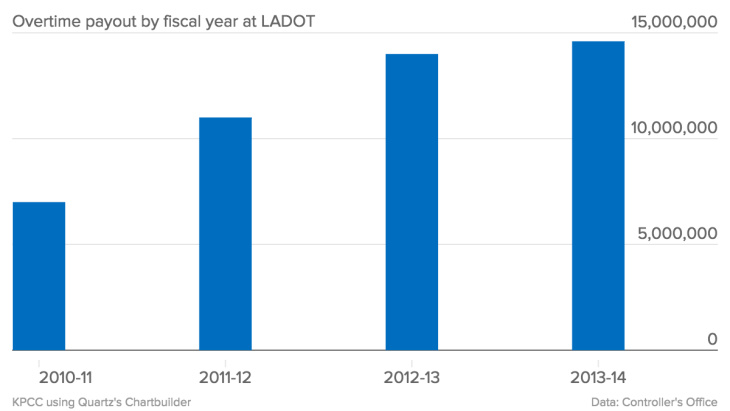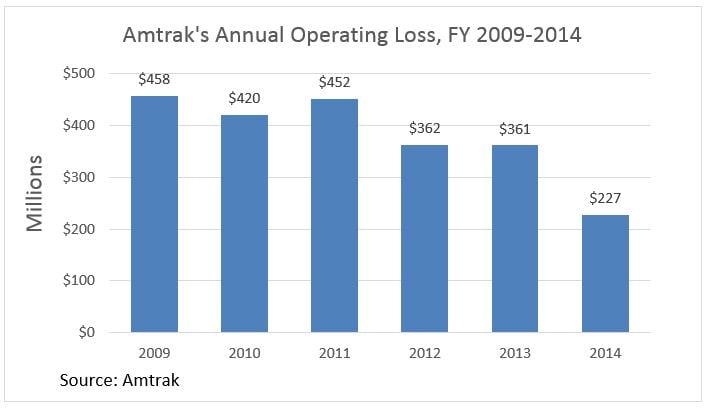
You might already be aware of the risks of excessive overtime on employee health and overall productivity. Then there's employee overtime that seems unreasonable. On its face, these are overtime hours that should not pass any smell test and they usually result from a combination of timesheet fraud, poor time tracking and monitoring systems.
LADOT Audit Uncovers Millions in Overtime
In May 2015, the office of Los Angeles City Controller Ron Galperin released the shocking findings of its audit of the L.A. Department of Transportation (LADOT). The audit was triggered by an anonymous tip alleging overtime abuse.
Focusing on the LADOT’s paint and sign division, the audit found “staggering” amounts of overtime that ultimately cost the city $3.3 million in a single fiscal year. The LADOT paid out more over time in 2013-2014 than any other city department, with the exception of the Fire Department.
30 out of 67 employees in the paint and sign division claimed over 1,000 hours of over time in the last fiscal year, with seven of those employees claiming over 2,000 hours of overtime, or 38 hours of overtime per employee per week.
Four supervisors clamed $70,000 in overtime, and one manager received $155,319 in overtime on top of his $78,000 salary. The trend in the LADOT as a whole has been worse, with overtime claims more than doubling over the last four years.

Regarding the audit’s findings, Galperin commented: “One might reasonably conclude that at least some of the employees in the Traffic Paint and Sign section were committing payroll fraud.” In the end, no criminal charges were brought stemming from the fact that the appropriate supervisors approved all employee timesheets and there were no detailed records of work completed by employees that might have justified the overtime hours claimed.
After the audit, LADOT brought in a new general manager who has been working on decreasing overtime costs.

Amtrak’s Mismanaged Time Tracking
Also known as The National Railroad Passenger Corp., Amtrak was established in 1970 and began operations in 1971. Since then, Amtrak has cost the federal government over $45 billion in taxpayer subsidies running millions of dollars in operating losses each year. While this might not entirely be Amtraks fault, as its charter is to serve necessary but unprofitable routes, critics have long lamented their overstaffed trains and the poor management of its food services.

In a June 2015 audit report from Amtrak’s Office of Inspector General (OIG) the OIG uncovered apparent widespread timesheet abuse by Amtrak employees. The report described trends and patterns in employee timesheet data for 2014 that “indicate potential fraud, waste, and abuse in the reporting of overtime and regular time.”
In 2014, Amtrak employees' claimed overtime added up to $199 million, or 19% of total wage costs.
The report detailed very specific cases of employees claiming seemingly unreasonable amounts of overtime. In one example, a locomotive technician claimed 90 hours of overtime in a single week.
Multiple Amtrak employees claimed overtime hours on 957 submitted weekly timesheets with no regular time worked at all. For example, nine employees were paid for 100 or more hours of overtime, but reported no paid regular time. Many daily timesheets exceeded 24 hours in a single day. Ten employees claimed more than 40 hours in a day, and one brazen employee claimed 48 hours in a single day.
In the end, it's unclear whether criminal charges will be brought. The report attributed discrepancies in time recording to the complex and “unique timekeeping absence and attendance codes” used by Amtrak, also noting that there are “six timekeeping systems to process timesheets and calculate wage payments.” Underlying these issues is the fact that Amtrak's employees have 14 different unions and are paid according to 23 different collective bargaining agreements.
How You Can Address Excessive Overtime
Thankfully, there are several time keeping best practices that can help your company avoid many of the problems of excessive overtime: Most of these require automated payroll timesheet software:
- With a paper-based manual timesheet system supervisors can have a very difficult if not impossible time approving employee timesheets. This is especially true when a manager has to supervise and approve the time and pay of employees whose pay rules are governed by different unions and agreements.
- Timesheet validation rules can enforce "maximum hours per day" rules that would prevent employees from claiming more than 24 hours in a single day. While most OSHA and labor rules should prohibit maintenance workers or locomotive operators from working excessive shift hours, simple validation rules that put a hard 24-limit are a good start for any time tracking system.
- Regular Time validation rules are as important as the proper calculation of overtime. In fact, for normal shifts, overtime hours generally should never be accrued before forty hours of regular time are worked. There might be union overtime rules that create exceptions, such as daily overtime rules after eight or ten hours worked, holidays or weekend days worked, but any adequate time tracking system should be able to accomodate such regular time and overtime rules processing as well.
- Payroll approvals of employee timesheets can be a hot-house pressure cooker of a process, with relatively few resources to review hundreds or thousands of timesheets to make payroll on time. An automated "Excessive Overtime Report" can flag employee timesheets with overtime that exceeds certain threshholds. Additional validation reports can stop timesheets with overtime that do not have the requisite regular time hours totals.
Overtime tracking is only part of a larger approach needed to tracking employee time in an efficient way.



